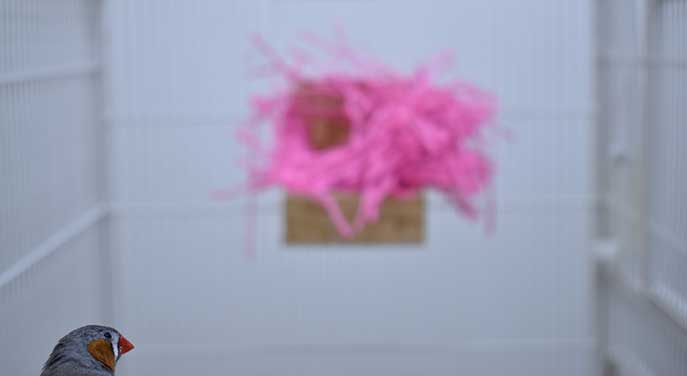
A male zebra finch observes a nest made from pink fibres. A new U of A study shows the birds can learn to build a nest by observing an empty nest, but only if they first learn what a nest is used for. (Photo courtesy of Andrés Camacho-Alpízar)
Like archeologists learning how past humans built their homes, birds can learn construction techniques by observing unoccupied nests, according to a new study.
University of Alberta scientists found that zebra finches learn about nest building by observing an empty nest – but only if they first learn what a nest is.
“We gave half our birds the opportunity to learn what a nest is by allowing them to observe other zebra finches using a nest built from white material,” said Andrés Camacho-Alpízar, lead author and PhD student in the Animal Cognition Research Group in the Department of Psychology.
After allowing half the birds to learn what a nest is, the team measured which colour, between pink and orange, each bird preferred. They then showed all the birds another empty nest built from the colour they didn’t prefer.

A male zebra finch selects pink material to build a nest. Researchers found that birds tended to build nests using the same colour material that they had seen in an empty nest – showing evidence of social learning without having to directly observe other birds. (Photo courtesy of Andrés Camacho-Alpízar)
Finally, the team let the birds build their first nests using pink and orange material. They found that the birds that had observed other birds used material of the same colour as the unoccupied nest they observed – showing evidence of social learning from the old nest.
“These results show that animals can learn about structure building not only from directly observing other individuals engaged in building but also from observing the products of others’ building behaviour,” said Camacho-Alpízar.
How zebra finches choose materials for their nests by Katie Willis
Observations of tool-using animals in the wild have revealed a role for discarded items in social learning. For example, Camacho-Alpízar explained, young capuchin monkeys prefer to use rocks that were previously used by other individuals to practise crack-opening seeds. Studying construction behaviour in birds in a controlled environment allows scientists to fully explore this learning process.
“The results from this nest-building study are exciting because they show experimental evidence that social learning is not limited to simply watching other animals behave in real-time. Rather, animals can also learn from the products of behaviour long after the animals that built the artifact are gone – much like archeologists learning from inspecting artifacts left by previous humans,” said Lauren Guillette, assistant professor in the Department of Psychology, who supervised the research.
The research was funded by the Natural Sciences and Engineering Council of Canada and through the University of Alberta Faculty of Science startup grant program.
The study, “Learning about construction behaviour from observing an artefact: Can experience with conspecifics aid in artefact recognition?” was published in Animal Cognition.
| By Andrew Lyle
This article was submitted by the University of Alberta’s Folio online magazine. The University of Alberta is a Troy Media Editorial Content Provider Partner.
© Troy Media
Troy Media is an editorial content provider to media outlets and its own hosted community news outlets across Canada.

